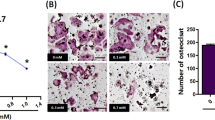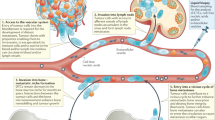Abstract
TWO principal mechanisms seem to be responsible for the bone destruction associated with skeletal metastases. The earlier and quantitatively most important mechanism seems to be mediated by osteoclasts stimulated by material produced by the tumour1. We now report evidence that this material is, or contains, prostaglandin. There are precedents for such a conclusion. Various tumours contain prostaglandins2, which resorb bone in organ culture3. Prostaglandin formation may explain the growth of dental cysts in the human jaw4, and prostaglandin synthetase inhibitors reduce tumour-induced osteolysis5 and hypercalcaemia6.
This is a preview of subscription content, access via your institution
Access options
Subscribe to this journal
Receive 51 print issues and online access
$199.00 per year
only $3.90 per issue
Buy this article
- Purchase on Springer Link
- Instant access to full article PDF
Prices may be subject to local taxes which are calculated during checkout
Similar content being viewed by others
References
Galasko, C. S. B., Nature, 263, 000 (1976).
Sykes, J. A. C., and Maddox, I. S., Nature new Biol., 237, 59–61 (1972).
Klein, D. C., and Raisz, L. G., Endocrinology, 86, 1436–1440 (1970).
Harris, M., Jenkins, M. V., Bennett, A., and Wills, M. R., Nature, 245, 213–215 (1973).
Powles, T. J., Clark, S. A., Easty, D. M., Easty, G. C., and Nevill, A. M., Br. J. Cancer, 28, 316–121 (1973).
Voelkel, E. F., Tashjian, A. H., Jr, Franklin, R., Wasserman, E., and Levine, L., Metabolism, 24, 973–986 (1975).
Galasko, C. S. B., J. Bone Jt. Surg., 57 -B, 353–359 (1975).
Bennett, A., Stamford, I. F., and Unger, W. G., J. Physiol., Lond., 229, 349 (1973).
Unger, W. G., Stamford, I. F., and Bennett, A., Nature, 233, 336–337 (1971).
Stamford, I. F., and Unger, W. G., J. Physiol., Lond., 225, 4P–5P (1972).
Bennett, A., McDonald, A. M., Simpson, J. S., and Stamford, I. F., Lancet, i, 1218–1220 (1975).
Bennett, A., Charlier, E. M., McDonald, A. M., Simpson, J. S., and Stamford, I. F., Prostaglandins, 11, 461–463 (1976).
Vane, J. R., Nature new Biol., 231, 232–235 (1971).
Tashjian, A. H., Jr, Voelkel, E. F., Goldhaber, P., and Levine, L., Fedn Proc., 33, 81–86 (1974).
Seyberth, H. W., et al., New Eng. J. Med., 293, 1278–1283 (1975).
Plescia, O. J., Smith, A. H., and Crinwich, K., Proc. natn. Acad. Sci. U.S.A., 72, 1848–1851 (1975).
Author information
Authors and Affiliations
Rights and permissions
About this article
Cite this article
GALASKO, C., BENNETT, A. Relationship of bone destruction in skeletal metastases to osteoclast activation and prostaglandins. Nature 263, 508–510 (1976). https://doi.org/10.1038/263508a0
Received:
Accepted:
Issue Date:
DOI: https://doi.org/10.1038/263508a0
This article is cited by
-
Establishment of successively transplantable rabbit VX2 cancer cells that express enhanced green fluorescent protein
Medical Molecular Morphology (2015)
-
The relationship between urinary pyridinoline, deoxypyridinoline and bone metastasis in a rat breast cancer model
Breast Cancer (1999)
-
Increased urinary excretion of pyridinium cross-links as markers of bone resorption in bone metastases of lung cancer
Journal of Bone and Mineral Metabolism (1995)
-
The pathophysiology and management of spine metastasis from lung cancer
Journal of Neuro-Oncology (1995)
-
Ostéolyse tumorale maligne métastatique Données actuelles sur la physiopathologie et le traitement
Orthopedie Traumatologie (1994)
Comments
By submitting a comment you agree to abide by our Terms and Community Guidelines. If you find something abusive or that does not comply with our terms or guidelines please flag it as inappropriate.



